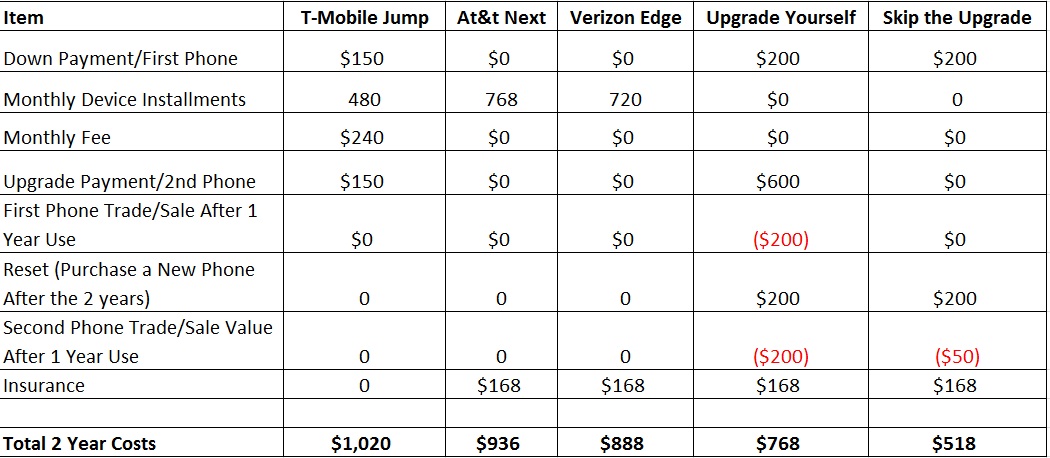The Real Cost to Upgrade - AT&T Next vs T-Mobile Jump Vs Verizon Edge Vs Sprint One Up

Recently, manufactures have been offering options to allow frequent upgrades of mobile devices at least once per year. But what is the best value for your money, AT&T Next, T-Mobile Jump, upgrading yourself, or skipping it completely. We take a look at the hidden costs to show you how to save your money.
Recently, manufactures have been offering options to allow frequent upgrades of mobile devices at least once per year. But what is the best value for your money, AT&T Next, T-Mobile Jump, upgrading yourself, or skipping it completely. We take a look at the hidden costs to show you how to save your money.
I have always hated the 2 year lock on my mobile phones. Phones are no longer just phones and mine is more often used as a camera, image hub, internet device, sharing device, and much more. I can use it to show off images to clients, pull up websites, manage my calendar, and many more things that are integral to my business as well as my communications. As a result, I have always loved the 1 year upgrade cycle as it allowed me to jump on board and take advantage of the new technologies available each year. However, in the past several years, this has become difficult. Wireless providers have taken away early upgrade perks, eliminated 1 year contract prices, and have increased the penalties for leaving your contract early. As a result, we have been almost forced into 2 year contracts…until now.
T-Mobile Jump
This program allows you to upgrade as often as twice a year at some cost. The program itself costs $10/month though it also includes insurance to your device. In addition, you must pay the monthly device installments (usually around $20/month) in addition to the down payment for the device. While this program looks more expensive, keep in mind that T-Mobile has reduced the cost of their plans to those that use these out of contract services while AT&T and Verizon are still charging the full amounts.
AT&T Next
The AT&T plan allows you to pay for your device over the course of 20 months with the option of upgrading your phone at 1 year. While this plan does not have any fees, it also does not include insurance which would need to be added for $7/month. It also does not require any upfront costs or upgrade costs which make it the ideal plan for those who do not have the money to put down upfront. AT&T allows you to pay for the phone by charging you $25-$50/month ($32 for the Galaxy S4). If you ever decide not to upgrade, AT&T will stop charging you this monthly fee after 20 months of paying it. Of course, you could always just pay the amount in full if you decide to leave AT&T.
Verizon Edge
This program is almost exactly the same as AT&T next except that you pay for your device over 24 months instead of 20. This means that we should be looking at a slightly cheaper per month charge for the device. The other advantage is that we can upgrade our device anytime we pay off 50% of the value of the device, so, if 6 months after picking up your phone you decide it is time for an upgrade, just pay the remaining balance of the monthly charge so you have paid 50% of the device cost, and trade it in for an upgrade!
Sprint One Up
Sprints program is a bit of a mixed bag. While not including the insurance options as T-Mobile does, it does offer a discount on your monthly service. While not quite as low cost as T-Mobiles service (unless you need unlimited data), Sprint's $65/month service does seem like an attractive option. That $15/month reduction of your bill for being a part of this service does expire at the end of the 24 month period so owning your device longer than 24 months would yield a price increase.
Do it yourself
So, your 1 year into your 2 year contract and you really want the new device that just came out, just buy it! Nothing is stopping you from paying the (usually) $600 and purchasing the device outright, swapping it out for your 1 year old phone, and selling your 1 year old phone for a couple hundred dollars. This is the most flexible options since you can upgrade at any time into your contract the minute the new device comes out. At the end of the 2 year contract you will be eligible for upgrade pricing again so thankfully the next phone should only cost you $200, plus you will then be able to sell your other now 1 year old phone for around $200+. Really, the only downside to this plan is the upfront costs associated with buying a phone retail for $600. However, you may be able to earn some miles, some instore credits, or use some lingering best buy gift cards to offset some of the cost.
Looking at the graph, it is clear to see that even though the cell providers are marketing this material as though it will save you money, it really will not. T-Mobiles option so far appears to be the most expensive of the options and by the end of the day, you will end up paying more for the device than it is worth. Instead, head to Amazon.com for the best prices on new phones, and just pick out any phone you would like to have on your carrier, purchase it for the full retail value, and then later cell your old device. Or just check out the prices below on the latest handsets:






